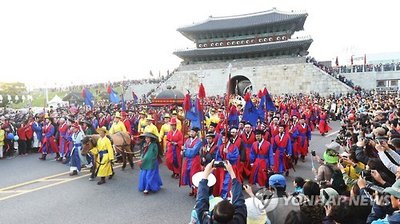SUWON, South Korea, Oct. 11, 2016 /PRNewswire/ -- Early Saturday morning, Changdeok Palace in central Seoul was crowded with people waiting to see the beginning of the reenactment of a royal procession carried out here hundreds of years ago.

As part of the 53rd Suwon Hwaseong Cultural Festival, which ran from Friday to Sunday, the city governments held hands to recreate King Jeongjo's parade from Seoul to the neighboring city of Suwon for a two-day run.
In 1795, the 22nd monarch of the Joseon Dynasty (1392-1910) embarked on an eight-day trip to Hwaseong Fortress in Suwon, which is 50 kilometers south of Seoul, for a pilgrimage to his late father, in line with the 20th anniversary of his reign and the 60th birthday of his mother Crown Princess Hong.
The UNESCO-designated cultural heritage site was built by the king in the late 18th century to demonstrate the latest technological developments, as well as his filial affection toward the late father.
The 2016 King Jeongjo Tomb Parade Reenactment recreated the royal procession on a route than spans a total of 45 km from the palace to the fortress. It marked the first time for the reenactment to start from the capital city. In the past, it only took place along the route in Gyeonggi Province surrounding Seoul.
Baek Seal-a, who lives in Uiwang, next to Suwon, drove all the way to Seoul with her 7-year-old and 9-year-old daughters to fully enjoy the festival.
"I first planned to go to Suwon directly, but then changed my mind to come to Seoul to see the opening ceremony," Baek said. "I didn't want to miss out this rare chance to show my kids what a 'royal procession' really looked like."
Saturday's parade began as dozens of the king's warriors on horses left the palace ahead of the monarch, followed by court musicians playing traditional Korean instruments to signal the king's march.
When King Jeongjo and his mother, Crown Princess Hong, emerged from Donhwamun, the main gate of Changdeok Palace, hundreds of audience members cheered. The audience had been waiting for them since the early morning.
South Korean actor Lee Kwang-ki, dressed in black "hanbok," traditional Korean clothing, took the role of King Jeongjo.
The role of Crown Princess Hong was played by Hwang Chee-seok, also dressed in traditional clothing made up of a red skirt and a top. She was one of the tens of ordinary citizens who were chosen among 600 to 700 people who applied to participate in the parade.
"I have spent a lot of time researching Jeongjo," she told Yonhap News Agency. "It is such an honor that I could take part in this historic reenactment of the parade from Seoul to Hwaseong Fortress."
Kim Hyo-jin, a local college student majoring in fashion, was at the opening ceremony with two of her friends to study traditional costumes.
"Our professor recommended that we visit the event, saying it will be a great opportunity to see court dresses," Kim said.
Mohd Zakaria from Malaysia, who visited Seoul with his wife for a seven-day trip, was one of the many foreigners who said they were "lucky" to discover the ancestral event.
"Yesterday I visited Changgyeong Palace, where I saw a bunch of young South Koreans walking around in traditional costumes," Zakaria said. "Today, we can only these court dresses worn by the royal family. It is very interesting to compare them."
As the 800-meter long parade went past Namdaemun, a historic gate located at the heart of the capital, and Seoul Station, citizens could not take their eyes off the rare spectacle and did not miss out the chance to take photos.
Running through the festival on Saturday were a court dress exhibition and a food market on Nodeul Island in Seoul's Han River, where visitors could try food served to King Jeongjo and Crown Princess Hong.
When the parade arrived on the island, people who were enjoying the exhibition and the food market welcomed the fair with a big round of applause.
"As I walked through the city, I could see the faces of our citizens, including homeless people at the train station," actor Lee said. "Though I will never be able to fully understand what King Jeongjo would have thought, I could tell why this parade had been a way for him to listen and learn what people need."
Lee also said he hopes the parade reminds Seoul citizens of the King's filial affection toward his parents.
After dance and music performances, the parade again embarked for Siheung Temporary Palace, where it stopped for the night before reaching the fortress via the nearby town of Anyang and Jijidae Hill at Suwon's entrance.
More than 1,200 people and 168 horses were mobilized for the event in Seoul alone.
"We hope this parade becomes Seoul's representative festival that can give a sense of pride to those who take part in the event, and joy to our citizens and tourists," said Chung Sang-hoon, a city official.
CONTACT:
Jung Soon Hyeong
j771015@korea.kr
+82-31-228-2061